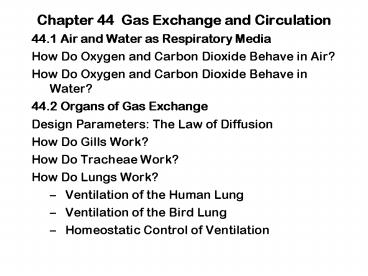Chapter 44 Gas Exchange and Circulation PowerPoint PPT Presentation
1 / 40
Title: Chapter 44 Gas Exchange and Circulation
1
- Chapter 44 Gas Exchange and Circulation
- 44.1 Air and Water as Respiratory Media
- How Do Oxygen and Carbon Dioxide Behave in Air?
- How Do Oxygen and Carbon Dioxide Behave in Water?
- 44.2 Organs of Gas Exchange
- Design Parameters The Law of Diffusion
- How Do Gills Work?
- How Do Tracheae Work?
- How Do Lungs Work?
- Ventilation of the Human Lung
- Ventilation of the Bird Lung
- Homeostatic Control of Ventilation
2
Important points
- Animals take in oxygen and expel carbon dioxide
to sustain cellular respiration. - Terrestrial animals and aquatic animals face
different challenges in performing gas exchange. - Gas exchange organs maximize the rate of oxygen
and carbon dioxide diffusion by presenting a
large, thin surface area to the environment. - Gas exchange organs function so as to maintain a
steep partial-pressure gradient that favors entry
of oxygen and elimination of carbon dioxide.
3
44.1 Air and Water as Respiratory Media
4
- Air or Water is the medium. The medium contains
oxygen carbon dioxide - Ventilation of gas exchanger (breathing but
confused by use of term respiration rate when
correct would be ventilation rate) - Gas exchange at a surface interface between
medium gas exchanger - Respiration equivalent to oxidative metabolism
5
(No Transcript)
6
Does Freeman need a geography lesson?
7
The amount of oxygen and carbon dioxide in water
varies also. The source of gases in water is the
atmosphere (mostly), and gas diffuses from the
atmosphere into water at the air/water
surface. Factor 1 ? surface/depth ratio Factor 2
? mixing
AIR AIR AIR AIR
AIR
8
FACTOR 2 MIXING
9
Gas exchange in water is much more difficult than
in air.
OK, so just move more of the medium past your gas
exchanger to compensate for the reduced amount of
O2 in water.
10
Oh yea, warm water holds less O2 than cold water
and salt water holds less than fresh water. So
tropical salt water fish have greatest burden.
11
Ficks law controls the rate of diffusion
12
(No Transcript)
13
(No Transcript)
14
There are many adaptations for ventilating gill
gas exchangers.
15
(No Transcript)
16
This is review recall that we already covered
counter-current exchange.
17
- Two basic strategies in fish for ventilating
gills - Ram jet ventilation
- Buccal pumping
Extreme ram jet ventilators some species of
sharks. They will suffocate if they stop swimming.
Extreme buccal pumpers sit-and-wait predators.
18
How the buccal pump works.
19
Insect terrestrial gas exchange --
Insects are relatively small, have relatively
lower metabolic rates. After invading land
discover that oxygen is relatively
abundant. So a simple system of internal
tubing, with spiracles opening to the outside, is
sufficient to keep open circulatory system
(hemocoel) perfused with oxygen. This system is
limiting, though, and has prevented larger
insects from evolving.
20
Hmm, some sort of breathing mechanism. What
could it be?
Of course you would jump right to the hypothesis
that flying is the answer. Not!
21
(No Transcript)
22
(No Transcript)
23
How about vertebrates invading land? Amphibians
are the first to do so
24
Amphibians inherit the fish buccal pump replace
oral valve with a nasal valve! Buccal pumping
uses positive pressure to inflate
lungs. Amphibians also use highly vascularized
dorsal skin as a gas exchange organ.
25
(No Transcript)
26
(No Transcript)
27
- From reptiles
- Birds evolve a unique ventilatory mechanism
- Mammals expand on reptile system
- Divide body cavity into abdominal and thoracic
sections (diaphragm separates the two) - Use intercostal muscles and diaphragm to expand
thoracic cavity and create negative pressure.
28
(No Transcript)
29
(No Transcript)
30
Basic mammalian lung plan
31
(No Transcript)
32
?
33
(No Transcript)
34
From amphibians on, surfactant is produced in
lungs to control water surface tension. The
surface tension is potentially so great it would
cause alveolar collapse and no reasonable
positive or negative pressure could inflate lungs.
35
(No Transcript)
36
Ventilation of the Bird Lung
37
Ventilation of the Bird Lung
38
(No Transcript)
39
Mechanism of bird lung ventilation
Valves ensure no backflow. Cross-current
exchanger (possible due to one-way rather than
tidal flow).
40
Homework Make sure you understand how
insufficient oxygen delivery to tissues leads to
a change in ventilatory rate (see page 1009).

